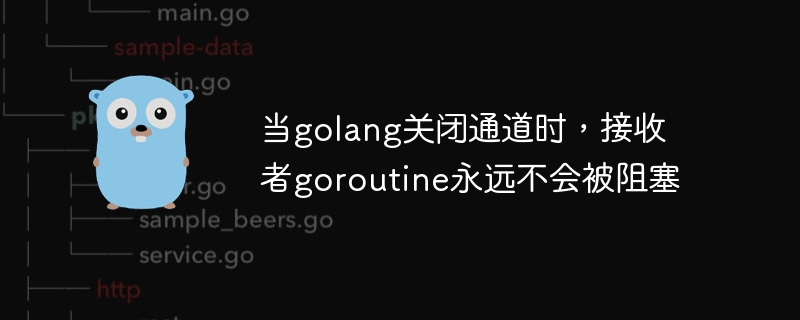當golang關閉通道時,接收者goroutine永遠不會被阻塞
- 王林轉載
- 2024-02-06 08:25:071333瀏覽

我寫了一些程式碼來學習go通道,如下所示的一段程式碼:
func main(){
intChan := make(chan int, 1)
strChan := make(chan string, 1)
intChan <- 3
strChan <- "hello"
fmt.Println("send")
// comment this, fatal error: all goroutines are asleep - deadlock!
// close(intChan)
// close(strChan)
for {
select {
case e, ok := <-intChan:
time.Sleep(time.Second * 2)
fmt.Println("The case intChan ok: ", ok)
fmt.Println("The case intChan is selected.", e)
case e, ok := <-strChan:
time.Sleep(time.Second)
fmt.Println("The case strChan ok: ", ok)
fmt.Println("The case strChan is selected.", e)
}
}
}
如果我註解掉 close() 函數,「for」語句就會被阻塞,正如錯誤提示“all goroutine are sleep - deadlock!”,這似乎是合理的。
如果我取消註解 close(),「for」語句永遠不會停止。接收方從通道取得預設值 0 和 nil,且從不阻塞。
即使我沒有向通道發送任何內容,並在定義通道後調用 close() 。接收器永遠不會阻塞或導致任何錯誤。
我對 close 函數的作用感到困惑,它是否啟動一個 go 例程將特定類型的預設值發送到通道,並且永遠不會停止?
正確答案
當頻道關閉時,您仍然可以閱讀它,但您的 ok 將為 false。所以,這就是為什麼你的 for 永遠不會停止。並且,您需要透過條件 if !ok {break } 來中斷 for 語句。
當通道未關閉時,當您嘗試從中讀取資料時,它會被阻塞或不被阻塞,這取決於緩衝/非緩衝通道。
緩衝通道:您指定大小 (make(chan int, 1))。
無緩衝通道:您沒有給出大小 (make(chan int))
在您評論close 的情況下,它將從您緩衝的通道讀取資料一次,因為您透過intchan 和<code>strchan 將資料傳送到通道。因此,您將看到控制台列印以下結果。
send the case strchan ok: true the case strchan is selected. hello the case intchan ok: true the case intchan is selected. 3
但是,此後,兩個緩衝通道都不再有資料。然後,如果您嘗試讀取它,您將被阻止,因為緩衝通道中沒有任何資料。 (實際上,無緩衝也是沒有數據時的情況。)
然後,你會得到 all goroutine are sleep - deadlock 因為主 goroutine 被阻塞以等待來自通道的資料。順便說一句,當你執行這個程式時,它會啟動一個主 goroutine 來運行你的程式碼。如果只有一個主 goroutine 被阻塞,那就意味著沒有人可以幫助你運行你的程式碼。
您可以在for語句之前加入以下程式碼。
go func() {
fmt.Println("another goroutine")
for {}
}()
你會發現你沒有遇到死鎖,因為仍然有一個 goroutine「可能」運行你的程式碼。
以上是當golang關閉通道時,接收者goroutine永遠不會被阻塞的詳細內容。更多資訊請關注PHP中文網其他相關文章!

